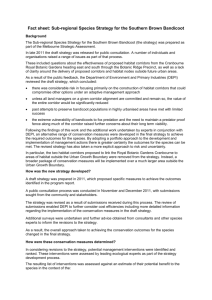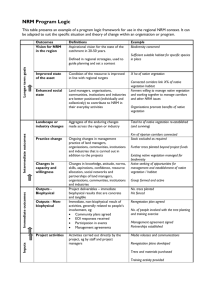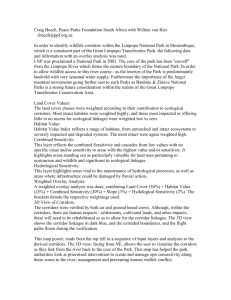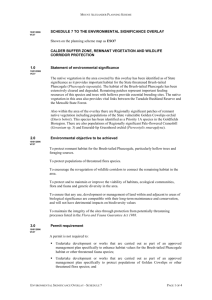4 - Bundaberg Regional Council
advertisement
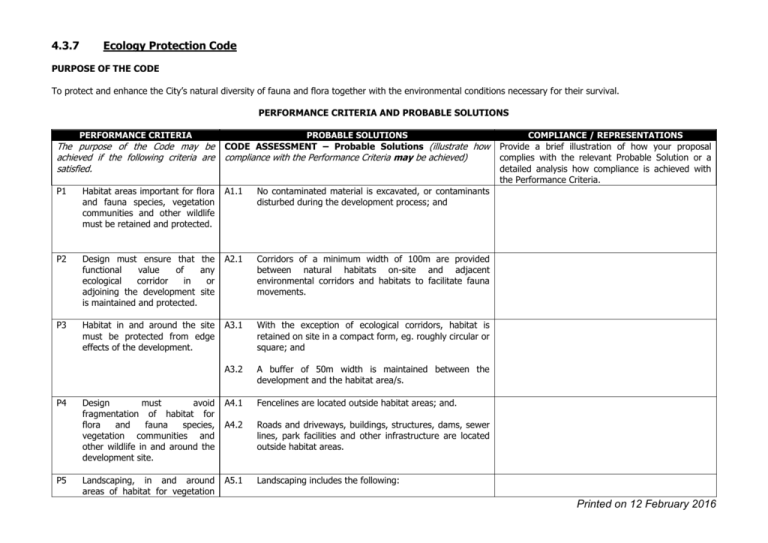
4.3.7 Ecology Protection Code PURPOSE OF THE CODE To protect and enhance the City’s natural diversity of fauna and flora together with the environmental conditions necessary for their survival. PERFORMANCE CRITERIA AND PROBABLE SOLUTIONS PERFORMANCE CRITERIA PROBABLE SOLUTIONS COMPLIANCE / REPRESENTATIONS The purpose of the Code may be achieved if the following criteria are satisfied. CODE ASSESSMENT – Probable Solutions (illustrate how Provide a brief illustration of how your proposal complies with the relevant Probable Solution or a detailed analysis how compliance is achieved with the Performance Criteria. P1 Habitat areas important for flora and fauna species, vegetation communities and other wildlife must be retained and protected. A1.1 No contaminated material is excavated, or contaminants disturbed during the development process; and P2 Design must ensure that the functional value of any ecological corridor in or adjoining the development site is maintained and protected. A2.1 Corridors of a minimum width of 100m are provided between natural habitats on-site and adjacent environmental corridors and habitats to facilitate fauna movements. P3 Habitat in and around the site must be protected from edge effects of the development. A3.1 With the exception of ecological corridors, habitat is retained on site in a compact form, eg. roughly circular or square; and A3.2 A buffer of 50m width is maintained between the development and the habitat area/s. Design must avoid fragmentation of habitat for flora and fauna species, vegetation communities and other wildlife in and around the development site. A4.1 Fencelines are located outside habitat areas; and. A4.2 Roads and driveways, buildings, structures, dams, sewer lines, park facilities and other infrastructure are located outside habitat areas. Landscaping, in and around areas of habitat for vegetation A5.1 Landscaping includes the following: P4 P5 compliance with the Performance Criteria may be achieved) Printed on 12 February 2016 PERFORMANCE CRITERIA PROBABLE SOLUTIONS species of local origin, including known food and habitat trees and shrubs; b. adjacent healthy remnant habitats, including understorey vegetation, are replicated as closely as possible; c. new plantings are located to create and/ or enhance links between existing habitats; d. plants that will not displace native flora species or degrade fauna habitat are used. The Plant Species List contained within Council’s Landscaping Planning Scheme Policy provides a guide to species selection. communities and other wildlife, must complement and enhance that habitat. P6 Stormwater discharge must not add pollutants nor cause erosion damage to ecology corridors COMPLIANCE / REPRESENTATIONS a. A6.1 Development within ecology corridors is to include appropriate measures such as scour protection and / or anti-pollutant devices. NOTES: The Information Requests Planning Scheme Policy is a guide to the information required by Council to assess development applications in relation to the Ecology Protection Code. ENVIRONMENTAL/ECOLOGICAL CORRIDORS Environmental Corridors retain bands of native vegetation in substantially undeveloped natural condition at the following minimum widths, to provide effective corridors for faunal movement and to preserve viable samples of representative on-site native vegetation. Some of this band width could be rehabilitated vegetation. Primary Environmental Corridors 60m Secondary Environmental Corridors 40m For further guidance on ecological corridor design, refer to the Department of Environment and Heritage’s Suggested Conservation Criteria for Development Assessment 1998. Printed on 12 February 2016







